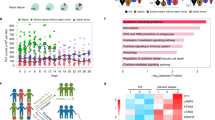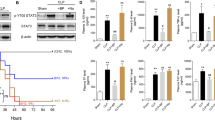Abstract
Platelets contribute to inflammation and their activation has been suggested as versatile effectors of sepsis. Activation of platelets promotes secretion of CD40L that induces sepsis and multiple organ dysfunction syndrome (MODS). However, the mechanisms regulate platelet-derived CD40L are not fully understood. Activation of PI3K/Akt pathway has been reported as a key component of sepsis, whereas the role of PI3K/Akt pathway in platelet-derived CD40L is unknown. In this study, we identified PI3K/Akt pathway as a key regulator of CD40L secretion by platelets. Significantly, inhibition of PI3K/Akt pathway by Ly294002 attenuated platelet activation and CD40L production. Moreover, PI3K/Akt pathway blocking suppresses vascular endothelial cells in vivo. Furthermore, the expression of biomarkers that represent the severity of sepsis, such as ICAM-1, VCAM-1, and E-selectin, was also suppressed by Ly294002. Altogether, our results confirm the pivotal role of PI3K/Akt pathway in sepsis and its inhibition might be a potential therapeutic target.






Similar content being viewed by others
References
Hou, T., D. Huang, R. Zeng, Z. Ye, and Y. Zhang. 2015. Accuracy of serum interleukin (IL)-6 in sepsis diagnosis: a systematic review and meta-analysis. International Journal of Clinical and Experimental Medicine 8 (9): 15238–15245.
Rossen, N.G., J.K. MacDonald, E.M. de Vries, G.R. D’Haens, W.M. de Vos, E.G. Zoetendal, and C.Y. Ponsioen. 2015. Fecal microbiota transplantation as novel therapy in gastroenterology: a systematic review. World Journal of Gastroenterology 21 (17): 5359–5371. https://doi.org/10.3748/wjg.v21.i17.5359.
Chew, M., M. Rahman, L. Ihrman, A. Erson, S. Zhang, and H. Thorlacius. 2010. Soluble CD40L (CD154) is increased in patients with shock. Inflammation Research 59 (11): 979–982. https://doi.org/10.1007/s00011-010-0213-5.
Guclu, E., Y. Durmaz, and O. Karabay. 2013. Effect of severe sepsis on platelet count and their indices. African Health Sciences 13 (2): 333–338. https://doi.org/10.4314/ahs.v13i2.19.
Vieira-de-Abreu, A., R.A. Campbell, A.S. Weyrich, and G.A. Zimmerman. 2012. Platelets: versatile effector cells in hemostasis, inflammation, and the immune continuum. Seminars in Immunopathology 34 (1): 5–30. https://doi.org/10.1007/s00281-011-0286-4.
Golebiewska, E.M., and A.W. Poole. 2015. Platelet secretion: from haemostasis to wound healing and beyond. Blood Reviews 29 (3): 153–162. https://doi.org/10.1016/j.blre.2014.10.003.
Stokes, K.Y., and D.N. Granger. 2012. Platelets: a critical link between inflammation and microvascular dysfunction. The Journal of Physiology 590 (5): 1023–1034. https://doi.org/10.1113/jphysiol.2011.225417.
Dewitte, A., S. Lepreux, J. Villeneuve, C. Rigothier, C. Combe, A. Ouattara, and J. Ripoche. 2017. Blood platelets and sepsis pathophysiology: a new therapeutic prospect in critical ill patients? Annals of Intensive Care 7 (1): 115. https://doi.org/10.1186/s13613-017-0337-7.
Aloui, C., A. Prigent, C. Sut, S. Tariket, H. Hamzeh-Cognasse, B. Pozzetto, Y. Richard, F. Cognasse, S. Laradi, and O. Garraud. 2014. The signaling role of CD40 ligand in platelet biology and in platelet component transfusion. International Journal of Molecular Sciences 15 (12): 22342–22364. https://doi.org/10.3390/ijms151222342.
Elgueta, R., M.J. Benson, V.C. de Vries, A. Wasiuk, Y. Guo, and R.J. Noelle. 2009. Molecular mechanism and function of CD40/CD40L engagement in the immune system. Immunological Reviews 229 (1): 152–172. https://doi.org/10.1111/j.1600-065X.2009.00782.x.
Kawabe, T., M. Matsushima, N. Hashimoto, K. Imaizumi, and Y. Hasegawa. 2011. CD40/CD40 ligand interactions in immune responses and pulmonary immunity. Nagoya Journal of Medical Science 73 (3–4): 69–78.
Wykes, M. 2003. Why do B cells produce CD40 ligand? Immunology and Cell Biology 81 (4): 328–331. https://doi.org/10.1046/j.1440-1711.2003.01171.x.
Elzey, B.D., T.L. Ratliff, J.M. Sowa, and S.A. Crist. 2011. Platelet CD40L at the interface of adaptive immunity. Thrombosis Research 127 (3): 180–183. https://doi.org/10.1016/j.thromres.2010.10.011.
Thorpe, L.M., H. Yuzugullu, and J.J. Zhao. 2015. PI3K in cancer: divergent roles of isoforms, modes of activation and therapeutic targeting. Nature Reviews. Cancer 15 (1): 7–24. https://doi.org/10.1038/nrc3860.
Chen, T.H., C.Y. Shih, W.L. Hsu, and T.C. Chou. 2015. Mechanisms of nifedipine-downregulated CD40L/sCD40L signaling in collagen stimulated human platelets. PLoS One 10 (5): e0127054. https://doi.org/10.1371/journal.pone.0127054.
Zhan, W., W. Wang, T. Han, C. Xie, T. Zhang, M. Gan, and J.B. Wang. 2017. COMMD9 promotes TFDP1/E2F1 transcriptional activity via interaction with TFDP1 in non-small cell lung cancer. Cellular Signalling 30: 59–66. https://doi.org/10.1016/j.cellsig.2016.11.016.
Kim, T. H., S. K. Ku, T. Lee, and J. S. Bae. (2012). 22504532. Food and Chemical Toxicology 50 (6):2188–2195. https://doi.org/10.1016/j.fct.2012.03.082.
Cognasse, F., H. Hamzeh-Cognasse, S. Lafarge, O. Delezay, B. Pozzetto, A. McNicol, and O. Garraud. 2008. Toll-like receptor 4 ligand can differentially modulate the release of cytokines by human platelets. British Journal of Haematology 141 (1): 84–91. https://doi.org/10.1111/j.1365-2141.2008.06999.x.
Lone, M.U., K.S. Baghel, R.K. Kanchan, R. Shrivastava, S.A. Malik, B.N. Tewari, C. Tripathi, et al. 2016. Physical interaction of estrogen receptor with MnSOD: implication in mitochondrial O2.- upregulation and mTORC2 potentiation in estrogen-responsive breast cancer cells. Oncogene. https://doi.org/10.1038/onc.2016.346.
Boisrame-Helms, J., H. Kremer, V. Schini-Kerth, and F. Meziani. 2013. Endothelial dysfunction in sepsis. Current Vascular Pharmacology 11 (2): 150–160.
Aird, W.C. 2003. The role of the endothelium in severe sepsis and multiple organ dysfunction syndrome. Blood 101 (10): 3765–3777. https://doi.org/10.1182/blood-2002-06-1887.
Cines, D.B., E.S. Pollak, C.A. Buck, J. Loscalzo, G.A. Zimmerman, R.P. McEver, J.S. Pober, et al. 1998. Endothelial cells in physiology and in the pathophysiology of vascular disorders. Blood 91 (10): 3527–3561.
Yaguchi, A., F.L. Lobo, J.L. Vincent, and O. Pradier. 2004. Platelet function in sepsis. Journal of Thrombosis and Haemostasis 2 (12): 2096–2102. https://doi.org/10.1111/j.1538-7836.2004.01009.x.
Vincent, J.L., A. Yagushi, and O. Pradier. 2002. Platelet function in sepsis. Critical Care Medicine 30 (5 Suppl): S313–S317.
Zonneveld, R., R. Martinelli, N.I. Shapiro, T.W. Kuijpers, F.B. Plotz, and C.V. Carman. 2014. Soluble adhesion molecules as markers for sepsis and the potential pathophysiological discrepancy in neonates, children and adults. Critical Care 18 (2): 204. https://doi.org/10.1186/cc13733.
Wang, Y., W. Yang, X. Zhao, and R. Zhang. 2017. Experimental study of the protective effect of simvastatin on lung injury in rats with sepsis. Inflammation 41: 104–113. https://doi.org/10.1007/s10753-017-0668-4.
Han, G., S. Geng, Y. Li, G. Chen, R. Wang, X. Li, Y. Ma, B. Shen, and Y. Li. 2011. gammadeltaT-cell function in sepsis is modulated by C5a receptor signalling. Immunology 133 (3): 340–349. https://doi.org/10.1111/j.1365-2567.2011.03445.x.
Chen, X.H., Y.J. Yin, and J.X. Zhang. 2011. Sepsis and immune response. World Journal of Emergency Medicine 2 (2): 88–92.
Aird, W.C. 2004. Endothelium as an organ system. Critical Care Medicine 32 (5 Suppl): S271–S279.
Aird, W.C. 2003. Endothelial cell heterogeneity. Critical Care Medicine 31 (4 Suppl): S221–S230. https://doi.org/10.1097/01.CCM.0000057847.32590.C1.
Ince, C., P.R. Mayeux, T. Nguyen, H. Gomez, J.A. Kellum, G.A. Ospina-Tascon, G. Hernandez, P. Murray, D. De Backer, and Adqi Xiv Workgroup. 2016. The endothelium in sepsis. Shock 45 (3): 259–270. https://doi.org/10.1097/SHK.0000000000000473.
Korthauer, U., D. Graf, H.W. Mages, F. Briere, M. Padayachee, S. Malcolm, A.G. Ugazio, L.D. Notarangelo, R.J. Levinsky, and R.A. Kroczek. 1993. Defective expression of T-cell CD40 ligand causes X-linked immunodeficiency with hyper-IgM. Nature 361 (6412): 539–541. https://doi.org/10.1038/361539a0.
Bertelli, R., A. Bonanni, A. Di Donato, M. Cioni, P. Ravani, and G.M. Ghiggeri. 2016. Regulatory T cells and minimal change nephropathy: in the midst of a complex network. Clinical and Experimental Immunology 183 (2): 166–174. https://doi.org/10.1111/cei.12675.
Aggarwal, A., D.J. Schneider, E.F. Terrien, B.E. Sobel, and H.L. Dauerman. 2004. Increased coronary arterial release of interleukin-1 receptor antagonist and soluble CD40 ligand indicative of inflammation associated with culprit coronary plaques. The American Journal of Cardiology 93 (1): 6–9.
Huang, J., C. Jochems, T. Talaie, A. Anderson, A. Jales, K.Y. Tsang, R.A. Madan, J.L. Gulley, and J. Schlom. 2012. Elevated serum soluble CD40 ligand in cancer patients may play an immunosuppressive role. Blood 120 (15): 3030–3038. https://doi.org/10.1182/blood-2012-05-427799.
Lerman, Y.V., and M. Kim. 2015. Neutrophil migration under normal and sepsis conditions. Cardiovascular & Hematological Disorders Drug Targets 15 (1): 19–28.
Bagshaw, S.M., S. Uchino, R. Bellomo, H. Morimatsu, S. Morgera, M. Schetz, I. Tan, C. Bouman, E. Macedo, N. Gibney, A. Tolwani, H.M. Oudemans-van Straaten, C. Ronco, J.A. Kellum, and for the Beginning and Ending Supportive Therapy for the Kidney (BEST Kidney) Investigators. 2007. Septic acute kidney injury in critically ill patients: clinical characteristics and outcomes. Clinical Journal of the American Society of Nephrology 2 (3): 431–439. https://doi.org/10.2215/CJN.03681106.
Cantley, L.C., and B.G. Neel. 1999. New insights into tumor suppression: PTEN suppresses tumor formation by restraining the phosphoinositide 3-kinase/AKT pathway. Proceedings of the National Academy of Sciences of the United States of America 96 (8): 4240–4245.
Acknowledgments
We thank Zhaoxiang Zhang (Shanghai Gefan Biotechnology CO. LTD) for expert technical assistance.
Funding
This work was supported by the Natural Science Foundation of Yichang of Hubei Province of China (A16-301-13), Chinese National Natural Science Foundation (81501045), and Chinese National Natural Science Foundation (81471839).
Author information
Authors and Affiliations
Corresponding author
Ethics declarations
The ethical approval of our experiments was approved from Human Subjects Institutional Review Board of China Three Gorges University (No. 2016014). Written informed consent was obtained from all patients or patients’ relatives, who were aware of the details of this experiment, including the aims and methods. Our animal studies were approved by the Animal Ethical Committee of Shandong University and were in accordance with the Institutional Animal Care and Use Committee of Shandong University.
Conflict of Interest
The authors declare that they have no conflict of interest.
Rights and permissions
About this article
Cite this article
Wan, P., Tan, X., Xiang, Y. et al. PI3K/AKT and CD40L Signaling Regulate Platelet Activation and Endothelial Cell Damage in Sepsis. Inflammation 41, 1815–1824 (2018). https://doi.org/10.1007/s10753-018-0824-5
Published:
Issue Date:
DOI: https://doi.org/10.1007/s10753-018-0824-5




